A “slow Italian”
Wesley So comments on his game with Leinier Dominguez
Leinier Dominguez Perez – Wesley So (FIDE Grand Prix 1 Pool D Berlin GER (4.1), 07.02.2022)
Back in beautiful Berlin. The last time I was here for the Candidates and I had a poor run but otherwise, got to love the city and the German people. This game was played in the 4th round, when Leinier and I were both on +1. Needless to say, the game was of prime importance in order to determine the leader of the group.
1.e4 Leinier has a very strong serve with 1.e4, which he always exclusively plays. Deep opening preparation and positional understanding are some of his best strengths.
1…e5 2.Nf3 Nc6 3.Bc4 Bc5 4.0–0 Nf6 5.d3 d6 I could also castle first: 5…0–0 6.c3 and here Black can play 6…d5 which is also full of theory.
6.c3 a5 In any case I decided to delay castling in order to discourage White from playing an early Bg5.
7.Re1 Ba7
This early retreat of the bishop is what Magnus played in the last game of the 2021 World Championship match against Ian Nepomniachtchi. I’d never seen it before.
8.Nbd2 0–0 9.h3 Be6 10.Bb5 10.Bxe6 fxe6 with the pawn on a5 controlling space, the doubled-pawns are not much of a problem for Black. White does not have his usual plan of advancing on the queenside with b4–a4.
10…Ne7 11.d4 Ng6 12.Ba4
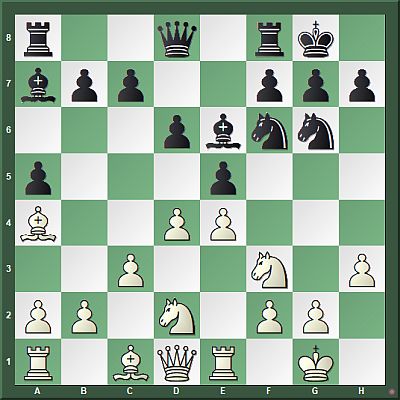
Leinier as usual knows the lines very well and goes for the most critical variation.
12…Nh5 This plan of bringing the knight to f4 seems like the best option for Black at the moment.
13.Nf1 Nhf4 The knight on f4 provides some active play, but at the same time it needs to be well supported otherwise it can be left there hanging.
14.Ng3 exd4 An interesting move here is 14…Qc8!? threatening to sac on h3 or g2.
15.Nxd4

Bxd4 It seems surprising to surrender the bishop pair, but it turns out the active knight on f4 and the idea to break in the center with …d5 compensates for it.
16.cxd4 The other possibility is 16.Qxd4 which seems more natural.
16…d5 17.Qf3 Qf6!?

This cunning move threatens the pawn on d4 as well as the …xh3+ trick.
18.Bd1!? Protecting the queen on f3, and keeping the tension going. This move surprised me a bit, although it is very natural. My preparation included 18.Kh2 Qxd4 19.Bxf4 Qxa4 20.Bxc7 Qd7 when the opposite colored bishops guarantee Black a safe position.
18…Qh4 19.Bd2 Black’s knight on f4 is a little stuck at the moment, but White can’t really take advantage of it. Therefore he continues his queenside development.
19…c6 20.Rc1 f5!?
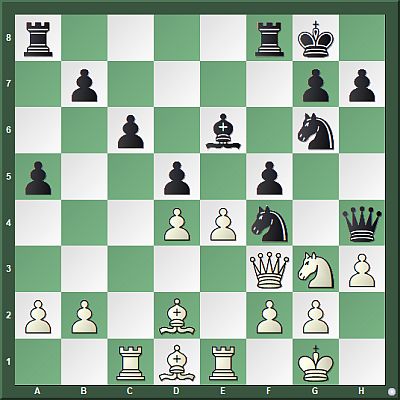
Forcing the issue, although it is probably premature. Best for Black is 20…Rae8 putting pressure along the e-file.
21.exf5 White decides to go for simplifications, but he played this move based on an oversight. More testing is 21.e5
21…Bxf5 22.Nxf5 Rxf5 The position of two bishops vs two knights is fascinating. Long-term the bishops have the advantage of course, so I will need to act fast.
23.Qg3? White hopes to get in Bg4 or Bc2 next, but he is not in time to do this. White should play 23.Bc2 Rg5 24.g3 Rf8 25.Bxg6.
23…Qxg3 24.fxg3 Nd3 25.Bc2 Rf2

This is the move Leinier missed when playing 21.exf5. No need to panic yet though, White is only slightly (more or less) worse.
26.Bxd3?! The ending after 26.Re3 Rxd2 27.Rxd3 Rxd3 28.Bxd3 Nf8 is not pleasant at all, but it’s the best chance White has to offer stiff resistance.
26…Rxd2 27.Bxg6? White’s last chance is 27.Bf5 Rxb2 28.Rb1 Black is a pawn up, but the win is still very far away. My knight is passive and my queenside pawns need defending.
27…hxg6
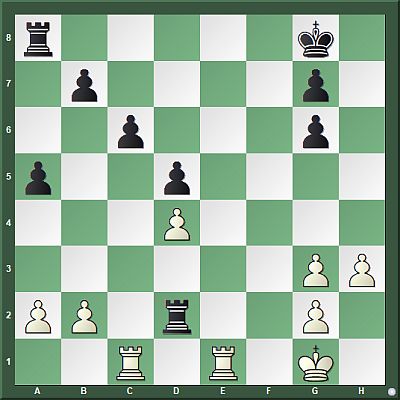
Now all rook endings are lost for White.
28.Re7 Rxb2 29.Rce1 Rf8 30.Rd7 White sets up a desperate attempt to double rooks along the 7th rank, but it’s not enough to save the game.
30…Rff2 31.Ree7 Rxg2+ 32.Kf1 Kh7 33.h4 Kh6
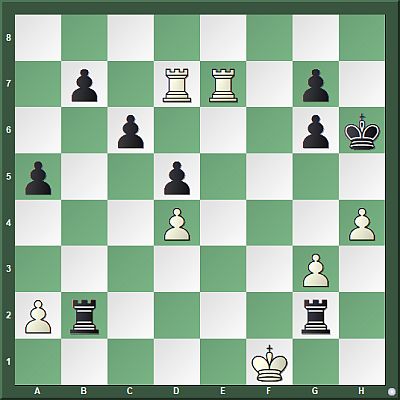
The king easily escapes the net through h5.
34.Re5 Rbf2+ 35.Ke1 Rxa2 36.Kf1 Rh2 37.Kg1 Rag2+ 38.Kf1 Rb2 39.Kg1 Rhd2
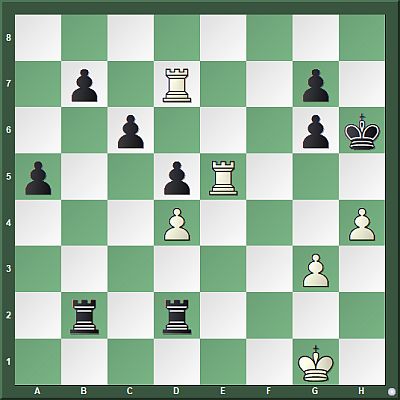
White is about to lose a fourth pawn and therefore he resigned. A nice game for me, although I did not have to do anything special as Leinier committed blunders on move 23 and 27.
You can find the complete and much more detailed analysis by Wesley So in the new ChessBase Magazine #207!
ChessBase Magazine #207
Order now at the ChessBase Shop !
Single issue: 19,95€ or annual subscription (6 issues) 99,70€. The different subscription offers for ChessBase Magazine (incl. ChessBase USB stick for new subscribers) can be found on the CBM homepage!
***********************************************************************
Content of ChessBase Magazine #207 (May 2022)
Highlights
The home page of ChessBase Magazine #207 welcomes you with the highlights of the issue! Just click, replay the annotated games or watch the videos and enjoy!
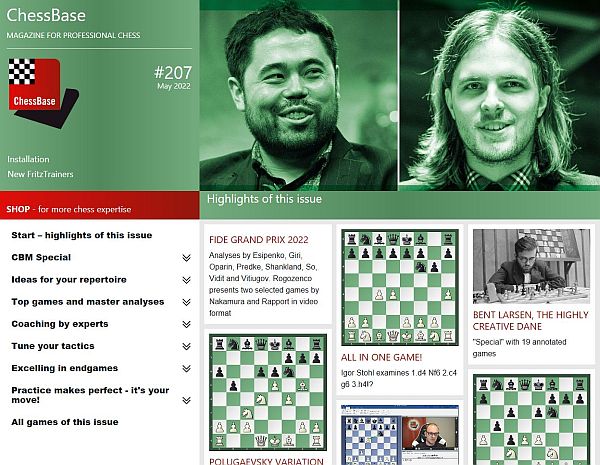
FIDE Grand Prix 2022: Analyses by Andrey Esipenko, Anish Giri, Vidit Gujrathi, Grigoriy Oparin, Alexandr Predke, Sam Shankland, Wesley So and Nikita Vitiugov. Dorian Rogozenco presents two selected games of the winners, Hikaru Nakamura and Richard Rapport, in video format. Or jump straight into the training and play through the game Aronian-Keymer from the Grand Prix “Move by Move” with Robert Ris! A complete repertoire against the Sicilian Alapin Variation? Markus Ragger presents his recommendations in his half-hour opening video. Don’t miss it: The “Special” on Bent Larsen with 19 commented games as well as analyses + video on the strategic skills of the great Dane!
Special: My favourite game by Bent Larsen
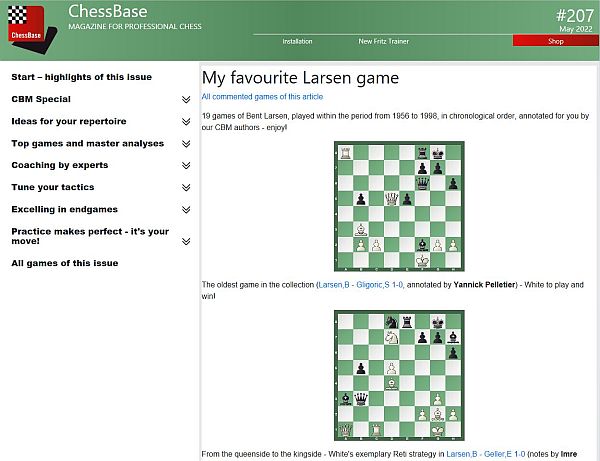
CBM authors analyse their favourite Bent Larsen games. An exclusive collection of 19 annotated games from 1956 to 1998 awaits you!
Top games and master analyses
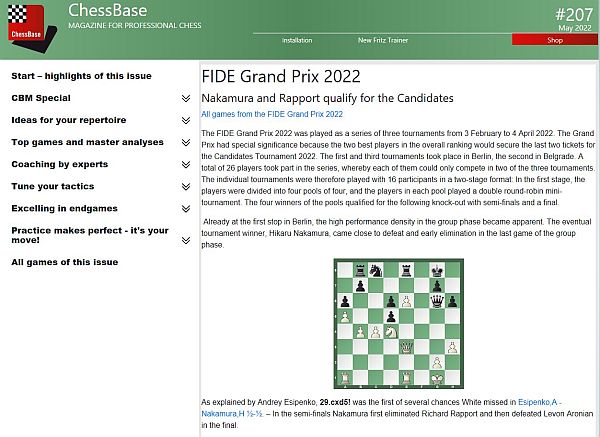
FIDE Grand Prix 2022: The Grand Prix was held as a series of three tournaments from 3 February to 4 April, the first and third of which were held in Berlin, the second in Belgrade. As overall winners Nakamura and Rapport qualified for the Candidates Tournament 2022. In this issue Andrey Esipenko, Anish Giri, Vidit Gujrathi, Grigoriy Oparin, Alexandr Predke, Wesley So, Sam Shankland and Nikita Vitiugov comment on their best games. And Dorian Rogozenco shows two games by Nakamura and Rapport in video format.
Airthings Masters 2022: Anish Giri comments on his short wins against Hans Niemann and Ding Liren
All in one
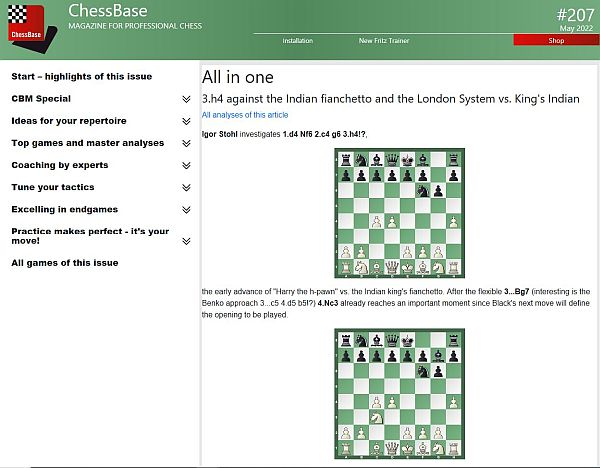
Everything you need to know about a specific line in one extensively annotated game – that is the concept of “All in one”. Igor Stohl examines the early advance of the h-pawn against the Indian King’s Fianchetto: 1.d4 Nf6 2.c4 g6 3.h4!? Bg7 4.Nc3. Tanmay Srinath tests the London System against King’s Indian: 1.d4 Nf6 2.Bf4 g6 3.e3 Bg7 4.Nf3 0-0 5.Be2 d6 6.h3.
Opening videos
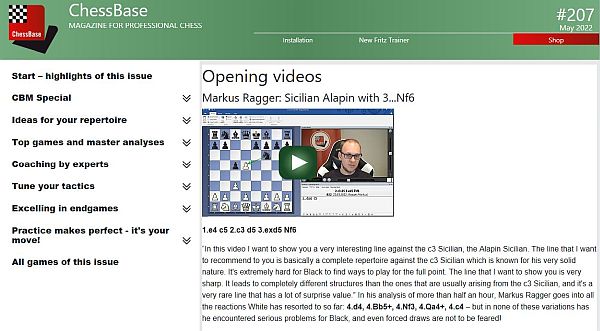
In the English Four Knights Game, the move 4.e4 is very popular. Rustam Kasimdzhanov examines the sometimes very sharp complications after 4…Bc5 and shows new ideas in his analysis, especially for Black. Markus Ragger presents a complete repertoire against the Alapin Variation with the side line 3…Nf6. And Mihail Marin shows an opening idea by Bent Larsen in the Sicilian Dragon Variation, which is still well playable today!
Rustam Kasimdzhanov: English Four Knights
1.c4 Sf6 2.Nc3 e5 3.Nf3 Nc6 4.e4 Bc5
Markus Ragger: Sicilian Alapin Variation
1.e4 c5 2.c3 d5 3.exd5 Nf6!?
Mihail Marin: Sicilian Dragon Variation
1.e4 c5 2.Nf3 d6 3.d4 cxd4 4.Nxd4 Nf6 5.Nc3 g6 6.Be3 Bg7 7.f3 Nc6 8.Qd2 0-0 9.Bc4 Qa5 10.0-0-0 Nxd4 11.Bxd4 Be6
New ideas for your repertoire
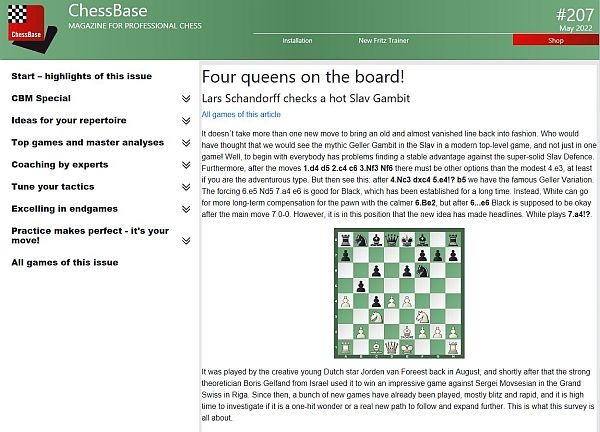
CBM #207 offers many new ideas and concepts for your next games with 11 opening articles:
Yago Santiago: Benko Gambit 3.d5 b5 4.cxb5 a6 5.e3
Spyridon Kapnisis: Modern Benoni Fianchetto Variation
Andrey Sumets: Caro-Kann Advance Variation 3…Bf5 4.h4 Qc7
Martin Lorenzini: Sicilian Alapin 6.Na3/8.Nb5
Petra Papp: Najdorf Polugaevsky Variation 7.f4 b5 8.e5
Tanmay Srinath: French Tarrasch 3…Be7 (Part II)
Krisztian Szabo: Philidor Reversed 1.e4 e5 2.Nf3 Nc6 3.g3
Robert Ris: Ruy Lopez 3…Bc5 (Part II) 4.c3
Lars Schandorff: Slav 4…dxc4 5.e4 b5 6.Be2 e6 7.a4!?
Alexey Kuzmin: Anti Gruenfeld 1.d4 Nf6 2.Nf3 g6 3.Nbd2
Sergei Grigoriants: Gruenfeld with 4.g3 and 7.Na3 c5
Topical opening traps
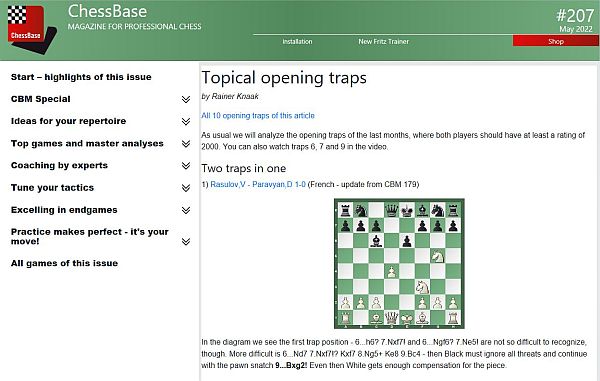
“Deceptive security and new insights” – Rainer Knaak takes a close look at 10 traps from current tournament practice three of which he also presents in video format.
Move by Move
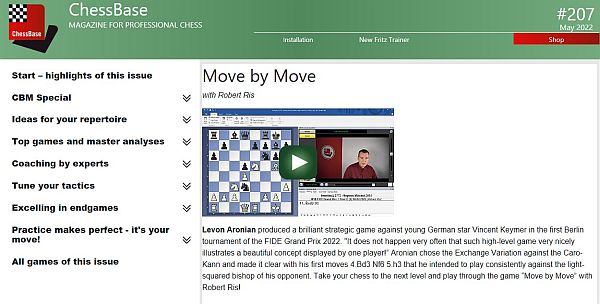
Test your chess move by move with Robert Ris! Levon Aronian’s strategic brilliancy against Vincent Keymer from the first FIDE Grand Prix is on the programme. Can you find the moves of the super grandmaster?
“Bent Larsen – a universal player”
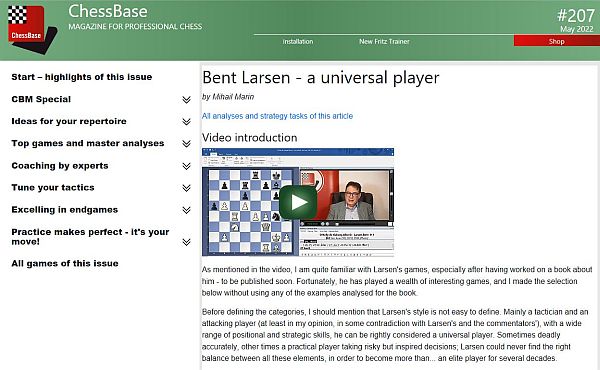
Mihail Marin sheds light on the strategic skills of the most important Danish grandmaster of all time. Incl. detailed video introduction (playing time: 34 minutes).
The Classic
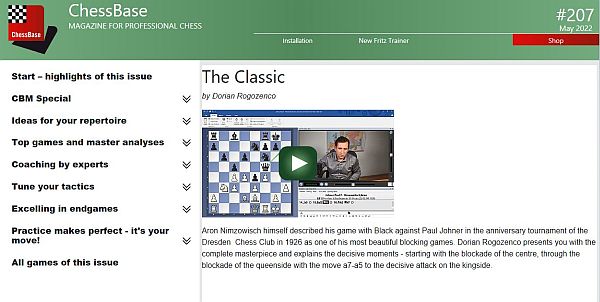
Aron Nimzowitsch described his game with the black pieces against Paul Johner at the anniversary tournament of the Dresden Chess Club in 1926 as “one of his most beautiful blockading games”. Enjoy Dorian Rogozenco’s presentation!
Tactics: “Magnetic square h7!”
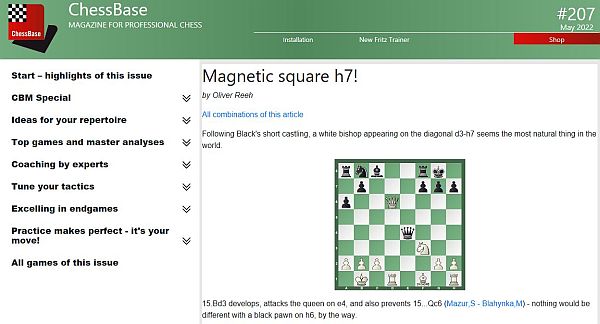
In Oliver Reeh’s tactics contribution with 34 games, everything is about the attraction of the square h7 on the attacking white pieces. Incl. interactive video training!
Excelling in endgames – “Endgame highlights by Bent Larsen” and much more.
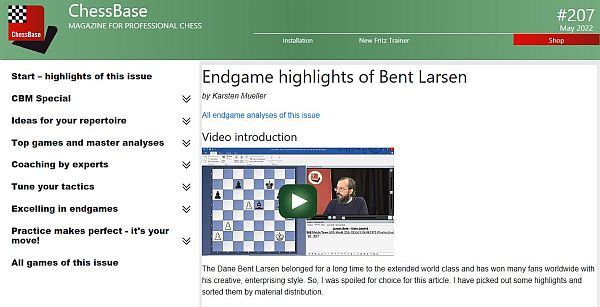
Karsten Mueller provides comprehensive training material for the highest demands: the most beautiful endgames by Bent Larsen as well as highlights from the first Berlin Grand Prix 2022. The endgame expert from Hamburg opens both contributions with a detailed video introduction. In addition, he provides further analyses in “Readers write”
Credit: Source link

